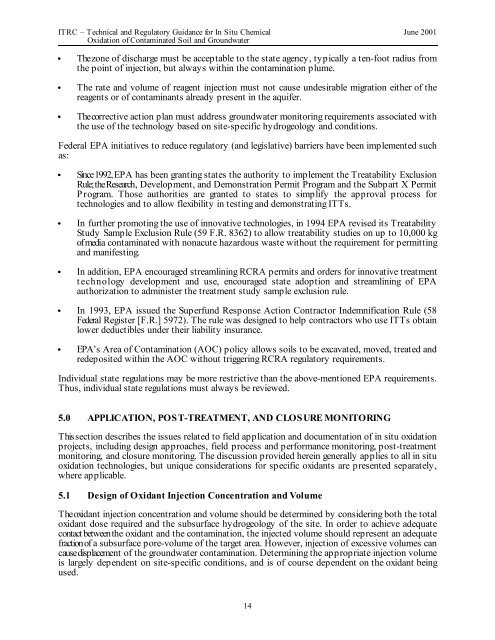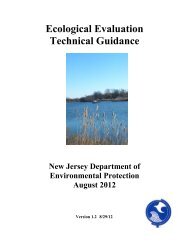Technical and Regulatory Guidance for In Situ Chemical ... - ITRC
Technical and Regulatory Guidance for In Situ Chemical ... - ITRC
Technical and Regulatory Guidance for In Situ Chemical ... - ITRC
Create successful ePaper yourself
Turn your PDF publications into a flip-book with our unique Google optimized e-Paper software.
<strong>ITRC</strong> – <strong>Technical</strong> <strong>and</strong> <strong>Regulatory</strong> <strong>Guidance</strong> <strong>for</strong> <strong>In</strong> <strong>Situ</strong> <strong>Chemical</strong> June 2001<br />
Oxidation of Contaminated Soil <strong>and</strong> Groundwater<br />
C<br />
C<br />
C<br />
The zone of discharge must be acceptable to the state agency, typically a ten-foot radius from<br />
the point of injection, but always within the contamination plume.<br />
The rate <strong>and</strong> volume of reagent injection must not cause undesirable migration either of the<br />
reagents or of contaminants already present in the aquifer.<br />
The corrective action plan must address groundwater monitoring requirements associated with<br />
the use of the technology based on site-specific hydrogeology <strong>and</strong> conditions.<br />
Federal EPA initiatives to reduce regulatory (<strong>and</strong> legislative) barriers have been implemented such<br />
as:<br />
C<br />
C<br />
C<br />
Since 1992, EPA has been granting states the authority to implement the Treatability Exclusion<br />
Rule; the Research, Development, <strong>and</strong> Demonstration Permit Program <strong>and</strong> the Subpart X Permit<br />
Program. Those authorities are granted to states to simplify the approval process <strong>for</strong><br />
technologies <strong>and</strong> to allow flexibility in testing <strong>and</strong> demonstrating ITTs.<br />
<strong>In</strong> further promoting the use of innovative technologies, in 1994 EPA revised its Treatability<br />
Study Sample Exclusion Rule (59 F.R. 8362) to allow treatability studies on up to 10,000 kg<br />
of media contaminated with nonacute hazardous waste without the requirement <strong>for</strong> permitting<br />
<strong>and</strong> manifesting.<br />
<strong>In</strong> addition, EPA encouraged streamlining RCRA permits <strong>and</strong> orders <strong>for</strong> innovative treatment<br />
technology development <strong>and</strong> use, encouraged state adoption <strong>and</strong> streamlining of EPA<br />
authorization to administer the treatment study sample exclusion rule.<br />
C <strong>In</strong> 1993, EPA issued the Superfund Response Action Contractor <strong>In</strong>demnification Rule (58<br />
Federal Register [F.R.] 5972). The rule was designed to help contractors who use ITTs obtain<br />
lower deductibles under their liability insurance.<br />
C<br />
EPA’s Area of Contamination (AOC) policy allows soils to be excavated, moved, treated <strong>and</strong><br />
redeposited within the AOC without triggering RCRA regulatory requirements.<br />
<strong>In</strong>dividual state regulations may be more restrictive than the above-mentioned EPA requirements.<br />
Thus, individual state regulations must always be reviewed.<br />
5.0 APPLICATION, POST-TREATMENT, AND CLOSURE MONITORING<br />
This section describes the issues related to field application <strong>and</strong> documentation of in situ oxidation<br />
projects, including design approaches, field process <strong>and</strong> per<strong>for</strong>mance monitoring, post-treatment<br />
monitoring, <strong>and</strong> closure monitoring. The discussion provided herein generally applies to all in situ<br />
oxidation technologies, but unique considerations <strong>for</strong> specific oxidants are presented separately,<br />
where applicable.<br />
5.1 Design of Oxidant <strong>In</strong>jection Concentration <strong>and</strong> Volume<br />
The oxidant injection concentration <strong>and</strong> volume should be determined by considering both the total<br />
oxidant dose required <strong>and</strong> the subsurface hydrogeology of the site. <strong>In</strong> order to achieve adequate<br />
contact between the oxidant <strong>and</strong> the contamination, the injected volume should represent an adequate<br />
fraction of a subsurface pore-volume of the target area. However, injection of excessive volumes can<br />
cause displacement of the groundwater contamination. Determining the appropriate injection volume<br />
is largely dependent on site-specific conditions, <strong>and</strong> is of course dependent on the oxidant being<br />
used.<br />
14
















